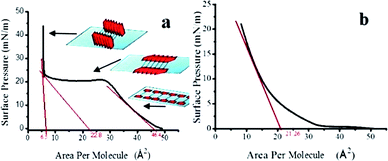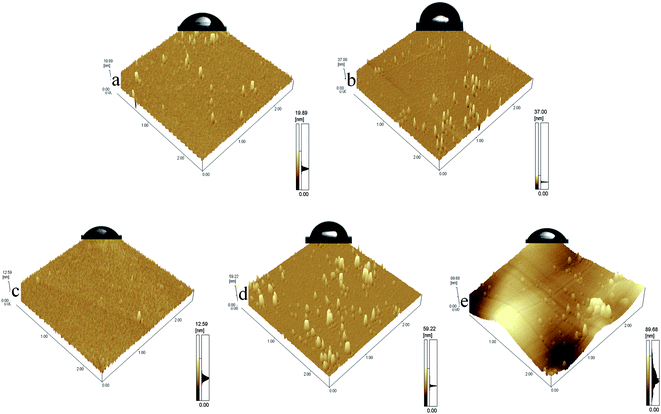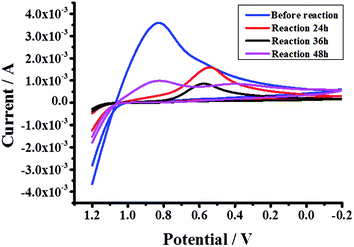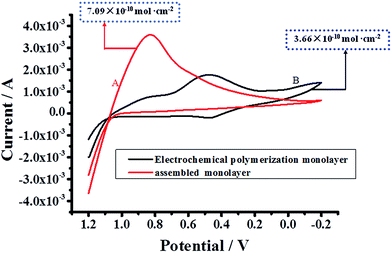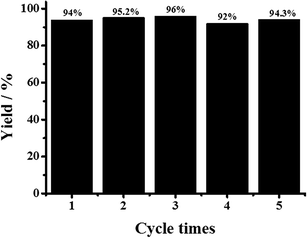An electrochemically polymerized and assembled cyclopalladated bi-thiophene imine for catalyzing coupling reactions: a modern strategy to enhance catalytic activity†
Keke Zoua,
Hui Liua,
Tiesheng Li*a,
Penglei Chenb,
Minghua Liu*b and
Yangjie Wu*a
aCollege of Chemistry and Molecule Engineering, The Key Lab of Nano-Information Materials of Zhengzhou, Zhengzhou University, Zhengzhou, 450052, P. R. China. E-mail: lts34@zzu.edu.cn; Fax: +86-371-67766667
bCAS Key Laboratory of Colloid, Interface and Chemical Thermodynamics, Institute of Chemistry, Chinese Academy of Sciences, No. 2 Zhongguancun Beiyijie, Beijing 100190, P. R. China. E-mail: liumh@iccas.ac.cn; Tel: +86 010-82615803
First published on 6th January 2015
Abstract
The catalytic activity and recyclability of self-assembled electrochemical polymerized 1,2-bis(3-thiophene imine) ethylene (B3TIE) and N-octadecyl-3-thiophenylimine (NOTPI) monolayers (ECP-SABM) with Li2PdCl4 were enhanced compared to those prepared without an electrochemical polymerized monolayer (SABM). This was also proven to be a universal rule for thiophene derivatives with these methods.
Introduction
Thiophene chemistry has been developed for a long time and is well established.1 Polythiophenes are an important representative class of conjugated polymers,2 among them, functional oligothiophenes have attracted comprehensive interest as π-conjugated materials.3 Furthermore, novel molecular architectures having more complicated conjugated structures and sophisticated topologies have emerged as a consequence of the increased versatility of thiophene chemistry and currently represent an interesting and quickly spreading field of research, in which a large number of transition metal-containing polythiophenes are of interest.4When metal chelating units are incorporated into thiophenes or polythiophenes, they show the electro-chromic behaviour of the polythiophene backbone, which is influenced by the coordinating metal center.5 Palladium is one of the most utilized and versatile transition metals in modern synthetic organic chemistry, and the scope of palladium-mediated cross coupling reactions continues to broaden,6 being commonly employed as bench test processes for new homo- and heterogeneous catalysts. Among the metal complexes, Schiff base complexes are identified usually as building blocks of new conjugated polymers and supramolecular structures and have been used as materials for applications.7 Umani-Ronchi and the Wolf group et al. recently explored the use of oligothiophenes as versatile ligands for catalysts based on the corresponding Pd complexes.8 The M. O. Wolf group then took an interest in constructing model complexes in order to probe their interesting electronic properties and their catalytic activity, which showed that the prepared cyclopalladated films were efficient in catalysing several cross-coupling reactions, including the Suzuki-, Heck-, and Sonogashira reactions, in a heterogeneous form which is easily recovered and reused without loss of activity.9
Films containing thiophene derivatives and their metal complexes, mentioned above, are prepared via self-assembled monolayers (SAMs) or the Langmuir–Blodgett (LB) method, which have attracted increasing interest during recent years because they allow a straightforward preparation of chemically tailored surfaces with specific chemical and physical properties.10 Among these are thiophene derivatives, which are adsorbed on Pt or Au surfaces or other substrates to form densely packed SAMs which are subsequently electropolymerized. The resulting thin films show high electrochemical stability.11 At the same time, the application of Langmuir–Blodgett (LB) techniques to conjugated polymers offers a unique approach for constructing molecular devices and more highly ordered thin films.12 Organometallic catalytic LB films used for catalysis were first investigated by K. Töllner et al.13 In our previous studies, we have synthesized a series of cyclopalladated ferrocenylimines (CPFIs), which show satisfactory reactivity in Heck, Suzuki, Sonogashira and Kumada reactions etc. in homogeneous catalysis,14 and also investigated the molecular orientation and morphology of CPFI in LB films which clearly demonstrated that ordered structures have a major influence on catalytic reactions.15 However, the LB films may desorb from solid slides to some extent when they are placed in organic solvents or under heating conditions, which would affect the experimental results. Cyclopalladated arylimine self-assembled films were then synthesized to overcome these disadvantages,16,17 which led to better results that improved the catalytic activity and recyclability.
Although the research conducted above using self-assembly or LB technology for fabricating functional films has achieved excellent results, few investigations of ordered catalyst films fabricated by combining LB technology, electrochemical polymerization and self-assembly (called LB-ECP-SA) have been presented. Therefore, considering the special properties of the thiophene unit, we designed and utilized electropolymerized thiophene imine LB films to afford ordered packing of the metal oligopolymer to try to enhance the activity and reusability. To this purpose, we report here a relatively unexplored strategy to prepare a highly ordered monolayer of a heterogeneous organometallic catalyst via self-assembly (SA) of an electrochemically polymerized (ECP) Langmuir monolayer (LB) of B3TIE with Li2PdCl4 (referred to as LB-ECP-SA).
Given our background in palladacycles and the requirements for the successful incorporation of transition metals into thiophene or polychiophene, we designed a bis-Schiff base-type group linking dithiophene group (see Scheme S1†), in which the Schiff base system was able to coordinate a broad range of transition metals.
Moreover, thiophene is an extremely well suited nucleus for specal purpose, because the more reactive 2- and 5-sites are left open, which are susceptible to electrochemical polymerization (ECP).18
Herein, the 1,2-bis(3-thiophene imine)ethylene (B3TIE) and N-octadecyl-3-thiophenylimine (NOTPI) monolayer at the water/air interface were characterized and can be transferred onto solid substrates to yield multilayers using the Langmuir–Blodgett (LB) method. The B3TIE monolayer or electropolymerized B3TIE monolayer deposited on the substrate was immersed in a solution of Li2PdCl4 to yield a self-assembled palladacycle monolayer (SABM), as shown in Scheme 1, and the palladacycle monolayer (ECP-SABM). It is worth noting that the catalytic activity and recyclability of ECP-SABM were enhanced more than those of the SABM and ECP-cast film, indicating that the molecular ordering and orientation are the crucial factors for improving catalytic activity. A similar result was also observed in the case of NOTPI, indicating that there may be a universal rule for thiophene derivatives prepared by this combination method (LB-ECP-SA). We attributed the higher catalytic activity to the ordered molecular packing, orientation and morphology of metal chelation with B3TIE, which is crucial in forming highly ordered, nanometer-sized domains with a high density of active centres. These results represent a fundamental advance in understanding the relationship between ordering, orientation and catalysis in heterogeneous catalysts and provide a general method to enhance the catalytic activity of thiophene-based palladium complexes for carbon–carbon coupling reactions.
Results and discussion
Behavior and characterization of the monolayer
B3TIE is not an amphiphile, and hence is not ideally suited to manipulation by the Langmuir technique. However, it was found that a good Langmuir monolayer could be made by judicious choice of surface pressure (SP). The surface pressure rises at a moderate rate with decreasing area until a surface pressure of 21 mN m−1 is attained, at which point, the rate of increase in the surface pressure with barrier compression decreases a little (Fig. 1a). This plateau region of the isotherm continues until a surface pressure ∼20 mN m−1 is reached. Further barrier compression leads to a much faster rate of surface pressure increase until evidence of film collapse appears at surface pressures >45 mN m−1.19Analysis of the first increase in surface pressure showed that the area per repeat unit when extrapolated to zero pressure corresponds to ∼46.4 Å2, roughly two times larger than that of a thiophene plane parallel to the water surface, an orientation in which the two thiophenes in one molecule lie parallel to the water surface.20,21 The shape of the isotherm of B3TIE is comparable to that reported by J. T. Groves et al.22 At 25 mN m−1, the mean molecular area is ∼6.5 Å2. This area is approximately half that of a single thiophene unit (14.5 Å2), as would be estimated for a close-packed monolayer with the dithiophene rings standing perpendicular to the air/water interface. On the other hand, NOTPI, with an imine and an alkyl chain in the repeat unit, exhibited small surface areas (∼21.26 Å2) with relatively gradual increases in surface pressure (without a plateau region) due to the hydrophobic function of the chain, and an orientation in which the thiophene plane faces toward the interface and the alkyl chain expands away from the interface was adopted(Fig. 1b). These results indicate that a monolayer with ordered packing could be achieved for both NOTPI and B3TIE.
Water contact angle (WCA) changes 23 and the morphologies of B3TIE monolayers deposited at different surface pressures (SP) on silicon were investigated with WCA and AFM as shown in Fig. 2. The water contact angles and surface configuration significantly changed, which meant that the B3TIE monolayer was successfully transferred onto the substrates.
To gain some insight into the monolayer, electrochemical characterizations of the B3TIE monolayer were performed. CVs of the B3TIE monolayer on ITO in HCl compared to bare ITO are shown in (a) and (b) (see Fig. S1†), respectively. A reduction peak of dithiophene imine at a potential of −0.2 to +0.3 V appeared, indicating that the B3TIE monolayer was deposited. In the case of the IR spectra, a peak at around 1640 cm−1 which is assigned to the imine group was observed, indicating that the B3TIE monolayer was transferred onto the substrate (Fig. S2†).
Characterization and catalytic properties of the B3TIE self-assembled film
The catalytic properties of the self-assembled B3TIE monolayer with Li2PdCl4 (SABM) were systematically investigated. The preparation of SABM is depicted in Scheme 1.Characterization with WCAs and AFM of the self-assembly of the B3TIE monolayer indicated that the surface configuration had significantly changed and that SABM was successfully obtained (see Fig. S3 and S4†). To determine the conditions necessary to obtain SABM and to verify the self-assembly time employed here, AFM processed images of SABM were measured (see Fig. S5†), in which the different roughnesses were measured as 0.546 nm, 1.969 nm, 3.021 nm, 2.260 nm and 4.732 nm, for (a) 0 h, (b) 24 h, (c) 36 h, (d) 48 h and (e) 72 h. There was some aggregation at 24 h and 36 h and extreme aggregation at 72 h. Therefore, the best time was selected as 48 h due to its tendency towards homo-packing.
The higher potential wave in the CVs at about 0.94 V, which is assigned to Pd2+, is irreversible (Fig. S6†); the reduction peak of Pd2+/Pd0 at a potential of 0.7 to 1.1 increased and shifted with increasing assembly time until 48 h and decreased for 72 h, indicating that SABM formation was completed at 48 h. It is also worth noting that in the expanded region from the inset of Fig. S6† the B3TIE peak at 0–0.2 V decreased quickly with increasing time, disappeared at 48 h and then, reappeared at 72 h. This is also consistent with the results obtained above.
As shown in the infrared spectra the peak at 1637 cm−1 shifted to 1632 cm−1, 1628 cm−1, 1625 cm−1 and 1632 cm−1, while the intensity decreased, with increasing self-assembly time (Fig. S7†). The changes to the peak at 1632 cm−1 assigned to the imine group are the evidence that the SABM was formed. The absorption of UV at 245 nm, which corresponds to the cyclopalladated arylimine, increased with increasing self-assembly time, which is evidence of SABM formation (Fig. S8†). In the case of X-ray photoelectron spectroscopy (XPS) of the SABM, the Pd (3d5/2) and Pd (3d3/2) peaks at 337.3 eV and 243.5 eV, respectively, were observed, which is consistent with Pd(II) (no Pd(0) or (IV) was detected), indicating that the SABM was fabricated (Fig. S9†). The Pd content of the catalyst was 7.09 × 10−10 mol cm−2 as detected by ICP-AES analysis, which is consistent with the calculated value.
The catalytic activities for the Suzuki coupling reaction catalysed by SABMs fabricated at different SPs were investigated as shown in Table S1.† The results showed that the best catalytic activity was observed at 12 mN m−1, indicating that molecular orientation is one of the crucial factors in the catalysis.15b We also examined the reuse of the SABM in the Suzuki coupling reaction between 4-bromotoluene and phenyl boric acid under different conditions as shown in Table S2.† Under the optimized conditions, the extension of the reaction to other substrates was also investigated in detail (see Table S3†).
Concerning the use of the catalyst both for industrial and pharmaceutical applications, recycling was an important point. The influence of stirring and solvent were investigated (Fig. S10(a)†); a high yield could be obtained without stirring (first cycle) and dramatically decreased in the second cycle due to the stirring, which resulted in the catalyst being removed from the substrate. On the other hand, recycling of SABM without stirring could be performed for four runs (Fig. S10(b)†) without a significant loss of catalytic activity (86%, 75% and 63% in sequence) (Table S4†). It should also be noted that new phenomena might arise from the ability to organize catalysts into controlled assemblies to enhance the catalytic activity. In the meantime, changes in molecular design can also be used to improve their recycling ability compared to our previous research.17
In order to ascertain whether the catalysis is authentically heterogeneous, aliquots of liquid were removed from a Suzuki reaction run to completion from which the catalyst film had been removed, and a fresh K2CO3 mixture was added. In this case, the formation of only trace coupling product was observed (48 h reflux). This demonstrates that negligible activity results from leaching of catalyst from the films and that the catalysis is heterogeneous. Moreover, control experiments with the unmodified electrode (80 °C, 48 h, trace) showed that the support neither significantly affects the activity of the SABM nor participates in the catalysis.
CV and AFM images of SABM on ITO after different catalysis times were taken to discuss the topographic and electrochemistry properties. The CV curve for the SABM acquired on ITO glasses showed obvious differences after the catalytic reactions (Fig. 3). The reduction peak before catalysis appeared from 0.7–1.0 V, shifted to a range from 0.3 V to 0.75 V during reaction and decreased in intensity after catalysis. This indicated that the catalysts after catalytic reaction became harder to reduce and easier to oxidize, probably because the Pd catalysts had changed from an oxidized state (Pd2+) to a reduced state (Pd0). This suggested that Pd0 was the catalytic activity center at the interface. It is interesting that the position of the reduction peak was restored to the initial state after 48 h although the intensity became weaker. A plausible reason is that the SABM was no longer ordered or covered by the reagents which were obstacles for the current.
The AFM images of the one-layer SABM acquired on silicon after different catalytic times are shown in Fig. 4. Smooth, ordered and uniform surface morphologies of SABM with rms (2.26 nm) was observed (Fig. S4d†), in which the WCA was 64.9°. However, Fig. 4a–e show the surface morphologies of SABM at different reaction times, in which remarkable morphological changes of catalyst film were detected. Disordered aggregation phenomenon on the catalyst film surface with higher Root Mean Square (rms) (35.5 nm, 27.7 nm, 77.7 nm, 25.5 nm, 23.4 nm) appeared (Fig. 4a–d) at about 0.5–6 hour of catalysis, which revealed that the drastic catalytic process had occurred. Regio-uniformity reappeared in Fig. 4e (rms, 39.5 nm) and a homogeneous and ordered pattern was observed when the catalytic reaction was nearly completed (Fig. 4f, rms, 45.7 nm). The morphological changes of the catalyst films were remarkable, as could be illustrated by the surface changes caused by the catalytic reaction.24
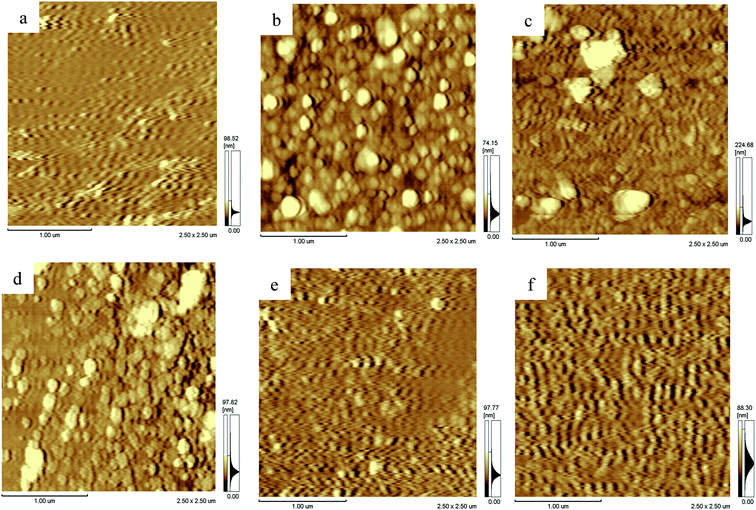 | ||
| Fig. 4 AFM images of the SABM during the process of the catalytic reaction, acquired on silicon at (a) 0.5 h, (b) 1 h, (c) 3 h, (d) 6 h, (e) 12 h and (f) 24 h. | ||
There was an interaction between the reactants and the catalyst support films which was consistent with previous studies.25 It could be illustrated by the surface changes made by the catalytically active Pd on catalyst films.26 These results indicated that the catalysis of the coupling reaction by SABM as a heterogeneous catalyst proceeded via a surface-catalysed process.
Catalytic properties of B3TIE fabricated by the LB-ECP-SA method
The catalytic activity of a self-assembled electrochemically polymerized B3TIE monolayer with Li2PdCl4 (referred to as ECP-SABM) was investigated (Scheme 2). The first electrochemical synthesis and its characterization as insoluble material were reported by Letheby.27 Considering the advantage of ECP, which typically couples oxidized state thiophene to yield oligomers or polymers whose solubility is often poor in solvents, we tried to utilize the electropolymerization of the B3TIE Langmuir monolayer to form a uniform polymer monolayer used for assembly with Li2PdCl4. It is expected to overcome the disadvantages of LB films as catalysts and enhance their catalytic activity as well as recyclability.In this experiment, the key advantages stem from combining polymer synthesis and film formation into a single step, limiting the need for oxidants to initiate polymerization. Moreover, it is well-known that morphological control can be achieved through the employment of LB technologies and ECP. The thiophene oxidative dimerization of the molecule was confirmed at positive potentials.28
Manipulation of the electrochemical parameters, such as the scanning run, can control oxidation states, yielding variable catalytic properties, while also controlling the local concentrations of the incorporated metal at the polymeric interface, which influences the local density at the interface. Therefore, optimization of the conditions of scanning laps was investigated (Table 1). Scanning times of 5–30 laps for the B3TIE monolayer on the ITO over the potential range 0–1.5 V resulted in an oligomer film (ECP-B3TIE) and then the ECP-B3TIE was immersed in a solution of Li2PdCl4 to yield ECP-SABM. The catalytic activity of ECP-SABM was investigated, and the B3TIE monolayer obtained after scanning 10 times over the complete potential range presented the highest catalytic property. The molecular weight of the electropolymerized monolayer (ECP-SABM) was also measured to be about 500 using GPC, indicating that mainly dimer was formed. So, 10 scan runs were selected for use in the further experiments as shown in Table 1.
| Entry | Scanning laps | Isolated yield (%) | TON |
|---|---|---|---|
| a Reaction conditions: PhB(OH)2 (0.30 mmol), 4-bromotoluene (0.25 mmol), K3PO4·7H2O (0.30 mmol), H2O (8 mL), TBAB (0.3 mmol), 40 °C for 48 h. SP = 12 mN m−1. | |||
| 1 | 5 | 43 | 8392 |
| 2 | 10 | 94 | 18![[thin space (1/6-em)]](https://www.rsc.org/images/entities/char_2009.gif) 345 345 |
| 3 | 15 | 73 | 14![[thin space (1/6-em)]](https://www.rsc.org/images/entities/char_2009.gif) 246 246 |
| 4 | 20 | 79 | 15![[thin space (1/6-em)]](https://www.rsc.org/images/entities/char_2009.gif) 417 417 |
| 5 | 25 | 84 | 16![[thin space (1/6-em)]](https://www.rsc.org/images/entities/char_2009.gif) 393 393 |
| 6 | 30 | 80 | 15![[thin space (1/6-em)]](https://www.rsc.org/images/entities/char_2009.gif) 613 613 |
The key role played by ECP-SABM in a high level of catalytic activity was further evidenced by comparison to the SA film analysis. Especially, the orientation of B3TIE in the electrochemically polymerized monolayer between the inner thiophene proved to be essential to create the stereochemical environment necessary to ensure high levels of chemical activity. The preparation of several catalyst films in different experiments (Cat. ED-SABM, SABM, ECP-SABM, ECP-SABM) is shown in Scheme 3 and their catalytic properties were explored (Table 2). It is obvious that ECP-SABM has higher catalytic activity than those prepared in other methods, indicating that the orientation of catalyst is one of the crucial factors in the catalysis. This method allowed the formation of nanometer size layers of ECP-SABM with normal orientation on the surface which can improve their catalytic activity.
| Entry | Yieldb (%) | Yieldc (%) | TON |
|---|---|---|---|
| a Reaction conditions: PhB(OH)2 (0.30 mmol), 4-bromotoluene (0.25 mmol), K3PO4·7H2O (0.30 mmol), H2O (8 mL), TBAB (0.3 mmol), 40 °C for 48 h.b Isolated yield.c Yield determined by GC, based on the product. | |||
| Cat. ED-SABM | 23.8 | 30.0 | 5503 |
| Cat. SABM | 82.4 | 89.6 | 6726 |
| Cat. ECP-SABM | 94.0 | >99.0 | 18![[thin space (1/6-em)]](https://www.rsc.org/images/entities/char_2009.gif) 345 345 |
| Cat. SABM-ECP | 31.4 | 39.2 | 7191 |
The characterization of ECP-SABM has been examined by infrared spectroscopy, UV spectroscopy, XPS, AFM, and water contact angle as follows: changes in the WCA of the hydrophilic substrate, B3TIE monolayer, ECP-B3TIE monolayer, B3TIE monolayer with Li2PdCl4 (SABM) and ECP-B3TIE monolayer with Li2PdCl4 (ECP-SABM) were measured, in which various WCAs were induced by changing the properties of the surface (Fig. S11†). The morphologies of the B3TIE monolayer, ECP-B3TIE monolayer, SABM and ECP-SABM on ITO surfaces were investigated (Fig. 5); the ECP-B3TIE monolayer (Fig. 5c) generated a regular Z-type line-like arrangement with a low rms (5.6 nm). This is in agreement with the experimental results that only thiophene parallel to the surface favors coupling steps with neighboring monomer moieties.29 A highly organized and closely packed Ziger–Ziger rodlike morphology of ECP-SABM could be formed from the ECP-B3TIE monolayer (Fig. 5e). However, in the case of SABM, regio-regular orientation (Fig. 5d) was observed. These different arrangements would be easy to control by the direct ECP method, which will influence their catalytic activity. That is to say that the preorganization of a close-packed B3TIE monolayer prepared by the LB method allows for the electrochemical generation of an ordered layer of the dimer that is highly organized and closely packed.
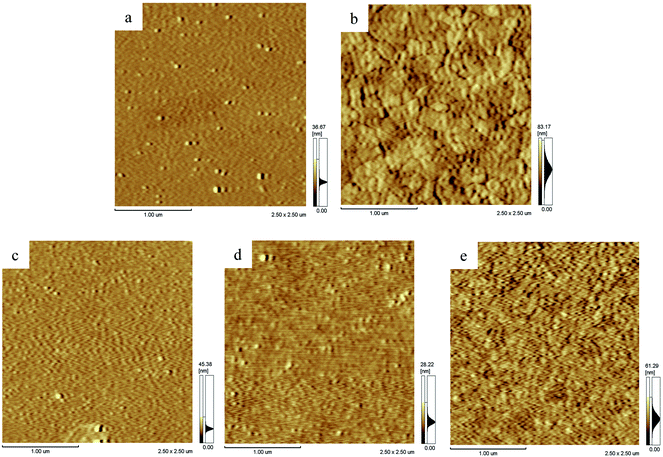 | ||
| Fig. 5 AFM images of (a) hydrophilic ITO; (b) B3TIE monolayer; (c) ECP-B3TIE monolayer; (d) SABM and (e) ECP-SABM. | ||
CVs of (A) SABM and (B) ECP-SABM are presented in Fig. 6. Compared to the CV of SABM, the voltammogram of (B) ECP-SABM showed a reversible wave, which contains a broad feature at lower potential assigned to the reduction of Pd0 (0.2–0.7 V) and an oxide peak at higher potential assigned to Pd2+ in the range from 0.3–0.7 V. It is possible that when the ECP-B3TIE monolayer was put into Li2PdCl4 solution, most of the palladium was chelated into the ECP-B3TIE monolayer in the form of Pd0 by the two nitrogens instead of cyclopalladated Pd2+ because palladium is a strong transition metal binding ligand used to facilitate and control the assembly of molecular architectures, resulting in an amount of Pd in ECP-SABM which is half that of the SABM shown in Fig. 4B. As we know that the active species in the initial process usually is Pd0, it is the reason that the catalytic activity of ECP-SABM is higher than that of SABM.
Fig. 7 presentes the results of the recycling of the ECP-SABM catalyst without stirring. Five runs were performed without significant loss of catalytic activity. The nice thing in these investigations was that new micro-phenomena of ECP-SABM might arise from the ability to organize molecular catalysts into controlled assemblies to enhance the catalytic activity and can also be used to improve their recycling abilities compared to SABM because the adhesive force of the substrate with the dimer is stronger than that with the monomer. In the meantime, it is also noted that the amount of Pd is a small loading,30 but high catalytic activity and recycling can be achieved with the combination method. Indeed, Pd chelated with ECP-SABM exhibited improved catalytic activity and stability. However, the structure of the catalyst in films was not clear, hindering discussion of the catalytic mechanism. So, rational design of suitable catalysts should be closely linked to deeper insights into the mechanisms involved at a molecular level in future.
Comparison experiment
Through the combination of LB technology, ECP, and self-assembly (LB-ECP-SA), the catalytic activity and recyclability of B3TIE can be enhanced according to the results obtained above. That is to say that it is also possible to tailor the degree of molecular order by LB technology, to enhance mechanical properties of films with ECP and to chelate metal in a certain form with the molecules to afford a higher order packing of the metallic oligopolymer film which exhibits significant catalytic properties. In order to thoroughly prove it, other catalytic films prepared in different ways, such as self-assembly of B3TIE cast films with Li2PdCl4 (SA-B3TIE-Cast) and self-assembly of electrochemical polymerized B3TIE cast films with Li2PdCl4 (SA-ECP-B3TIE-Cast), were designed and the results obtained are presented in Table 3, in which it is shown that the molecular orientation and fabrication are very important for higher catalytic activity.| Entry | Isolated yield (%) | TON |
|---|---|---|
| a Reaction condition: PhB(OH)2 (0.30 mmol), 4-bromotoluene (0.25 mmol), K3PO4·7H2O (0.30 mmol), H2O (8 mL), TBAB (0.3 mmol), 40 °C for 48 h. | ||
| SA-B3TcIE-Cast | 47.5 | 3877 |
| SA-ECP-B3TIE-Cast | 62.1 | 5069 |
| SABM | 82.4 | 6726 |
| ECP-SABM | 94.5 | 18![[thin space (1/6-em)]](https://www.rsc.org/images/entities/char_2009.gif) 345 345 |
To investigate whether or not the combination method used in the present research is universal, compounds containing the thiophene group were prepared in various ways. NOTPI LB films were prepared at different SPs, followed by self-assembly with Li2PdCl4 (SANOTPI) or by the ECP process and then self-assembly with Li2PdCl4 (ECP-NOTPI). The data are presented in Table 4. These results also showed that not only the orientation of NOTPI in the film but also the ECP technology play an important role for improving catalytic activity. Such a combination system used for thiophene-based compounds shows a model for improving catalytic activity, with which we can expand the functionality of the modified surface and provide new insights into the heterogeneous catalyst.
| Entry | SP (mN m−1) | Isolated yield (%) | TON |
|---|---|---|---|
| a Reaction condition: PhB(OH)2 (0.30 mmol), 4-bromotoluene (0.25 mmol), K3PO4·7H2O (0.30 mmol), H2O (8 mL), TBAB (0.3 mmol), 40 °C for 48 h. | |||
| 1 | 9 | 24 | 1959 |
| 2 | 11 | 55 | 4489 |
| 3 | 13 | 17 | 571 |
| 4 | 11 | 72 | 10![[thin space (1/6-em)]](https://www.rsc.org/images/entities/char_2009.gif) 253 253 |
Conclusion
1,2-Bis(3-thiophene imine)ethylene (B3TIE) and N-octadecyl-3-thiophenylimine (NOTPI) monolayers at the water/air interface were characterized and can be transferred on to solid substrates to yield multilayers by the Langmuir–Blodgett (LB) method. The B3TIE monolayer or electropolymerized B3TIE monolayer deposited on the substrate was immersed in a solution of Li2PdCl4 to yield a self-assembled palladacycle monolayer (SABM) and a palladacycle monolayer (ECP-SABM). It is worth noting that the catalytic activity and recyclability of ECP-SABM were enhanced more than that of SABM and ECP-cast film, indicating that the ordering and molecular orientation are the crucial factors for improving catalytic activity. A similar result was also observed in the case of NOTPI, indicating that there may be a universal rule for thiophene derivatives through this combination method (referred to as LB-ECP-SA). We attributed the higher catalytic activity to the ordered molecular packing, orientation and morphology of metal chelationwith B3TIE, which is crucial in forming highly ordered, nanometer-sized domains with a high density of active centres. These results represent a fundamental advancement in understanding the relationship between order, orientation and catalysis in heterogeneous catalysis and provide a general way to enhance the catalytic activity of thiophene-based palladium complexes for carbon–carbon coupling reactions.Experimental section
General
All solvents were obtained from commercial sources and used without purification. X-ray photoelectron spectroscopy (XPS) data were obtained with an ESCALab220i-XL electron spectrometer from VG Scientific using 300 W AlKα radiation. The base pressure was about 3 × 10−9 mbar. The binding energies were referenced to the C1s line at 284.8 eV from adventitious carbon. Scanning electron microscope images were taken using a JSM-6700 (10.0 kV). A SPM-9500 J3 (Shimadzu Corporation, Japan) was employed for AFM measurements in air at ambient temperature. Cyclic Voltammetry (CV) curves were obtained using a CH 1650A, experiments were performed in three electrode cells in 0.5 M HCl. The counter electrode was platinum; the reference electrode was Ag/AgCl/(0.1 M) KCl. All the Suzuki reactions were accomplished without the protection of inert gas. HPLC was conducted on a Waters 600 liquid chromatograph. Atomic Absorption Spectroscopy (AAS) analysis was obtained by a Z-8000 polarized Zeeman atomic absorption spectrophotometer (Hitachi Corporation, Japan). Melting points were measured using a WC-1 microscopic apparatus and are reported uncorrected. C, H, and N analyses were performed on a FLASH EA1112 analyzer. Infrared spectra were recorded on a Bruker VECTOR22 spectrophotometer. 1H NMR and 13C NMR spectra were recorded on a Bruker DPX-400 spectrometer in CDCl3 with TMS as an internal standard. Mass spectral data were acquired using an LC-MSD-Trap-XCT instrument. UV-visible absorption spectra were obtained using a Lambda 35 UV-Visible spectrophotometer (Perkin Elmer Inc. USA). The molecular weight was determined using PL-GPC 50 in tetrahydrofuran (THF) with polystyrene standards. Measurement of surface pressure (π)–area(A) isotherms and the deposition of monolayer were carried out using a computer controlled Langmuir trough Langmuir–Blodgett system (KSV-5000-3, KSV Instruments, Helsinki, Finland). The water contact angle was measured on an HARKE-SPCX1 instrument (Beijing).General synthesis process for NOTPI, B3TIE (Scheme S1†)
In a 50 mL flask, a mixture of alkylamine or alkyldiamine or 3-thiophenaldehyde (6 mmol), MgSO4 (15 mmol), 600 μL of 3-thiophenaldehyde and p-toluenesulfonic acid dissolved in 30 mL of CH2Cl2 was added. The mixture was stirred at room temperature for 48 h under nitrogen. The mixture was then filtered through a column with diatomite and the solvent was removed under reduced pressure. The residue was dissolved with a proper amount of dichloromethane again and methanol was added. The product was obtained by filtration, washed with methanol and dried under vacuum.![[double bond, length as m-dash]](https://www.rsc.org/images/entities/char_e001.gif) N–), 7.46 (2H, m, –CH–S–CH–), 7.2 (1H, s, –CH–CH–S–), 1.21 (34H, d, J = 8.1 Hz, CH3–(CH2)16–CH2), 0.80 (3H, t, CH3–). 13C-NMR (100 MHz, CDCl3): δ (ppm) = 154.11, 139.55, 126.99, 125.29, 124.75, 60.78, 28.69, 28.44, 28.36, 26.32, 21.68, 13.11.
N–), 7.46 (2H, m, –CH–S–CH–), 7.2 (1H, s, –CH–CH–S–), 1.21 (34H, d, J = 8.1 Hz, CH3–(CH2)16–CH2), 0.80 (3H, t, CH3–). 13C-NMR (100 MHz, CDCl3): δ (ppm) = 154.11, 139.55, 126.99, 125.29, 124.75, 60.78, 28.69, 28.44, 28.36, 26.32, 21.68, 13.11.![[double bond, length as m-dash]](https://www.rsc.org/images/entities/char_e001.gif) N–), 7.54 (4H, m, –CH–S–CH–), 7.30 (2H, m, –CH–CH–S–), 3.91 (4H, s, –CH2–N
N–), 7.54 (4H, m, –CH–S–CH–), 7.30 (2H, m, –CH–CH–S–), 3.91 (4H, s, –CH2–N![[double bond, length as m-dash]](https://www.rsc.org/images/entities/char_e001.gif) ). 13C-NMR (100 MHz, CDCl3): δ (ppm) = 156.0, 139.42, 127.49, 125.37, 124.68, 60.68.
). 13C-NMR (100 MHz, CDCl3): δ (ppm) = 156.0, 139.42, 127.49, 125.37, 124.68, 60.68.![[thin space (1/6-em)]](https://www.rsc.org/images/entities/char_2009.gif) :
:![[thin space (1/6-em)]](https://www.rsc.org/images/entities/char_2009.gif) 1) as eluent. Mp: > 300 °C.
1) as eluent. Mp: > 300 °C.Suzuki cross-coupling reactions
Aryl halide (0.25 mmol), aryl boric acid (0.3 mmol), catalyst (0.1 mmol%) and TBAB (0.3 mmol) were combined with base (0.3 mmol) and deionized water (1.5 mL) in a small round-bottom flask. The reaction mixture was stirred and then extracted with ethyl acetate three times. The combined organic phase was dried with MgSO4 and filtered, and the solvent was analyzed by gas chromatography.Self-assembly of dithiophene derivative monolayers with Li2PdCl4
The thiophene derivative monolayers deposited on substrates were put into a solution of Li2PdCl4 for a certain time and then taken out, and washed with methanol several times.Preparation of the Langmuir monolayer and LB films
A spreading solution of palladacycles was carefully spread onto the ultrapure water surface, and the Langmuir monolayer was compressed after evaporation of the solvent (all of the solvent was chloroform) for 30 min and stabilized for ca. 1 h in the uncompressed state at a compression speed of 5 mm min−1 at 20 ± 1 °C. LB films were transferred onto ITO glasses (for electrochemical study), quartz (for UV studies) and silicon slides (for AFM instruments and the catalysis study). The silicon, quartz and glass slides were cleaned in boiling concentrated H2SO4 for 1 h and then washed with pure water. The ITO glasses were ultrasonically washed in acetone, ammonia, ethanol and pure water in sequence.Hydrophilic treatment
The silicon and glass wafers were put into the mixed solvent of concentrated nitric acid and concentrated sulphuric acid (v/v = 2![[thin space (1/6-em)]](https://www.rsc.org/images/entities/char_2009.gif) :
:![[thin space (1/6-em)]](https://www.rsc.org/images/entities/char_2009.gif) 1) and heated to boiling for 1–1.5 h. Then, the wafers were washed using an amount of deionized water. The ITO glasses were ultrasonically washed in acetone, ammonia, ethanol and pure water in sequence.
1) and heated to boiling for 1–1.5 h. Then, the wafers were washed using an amount of deionized water. The ITO glasses were ultrasonically washed in acetone, ammonia, ethanol and pure water in sequence.
Inductively coupled plasma-atomic emission spectrometry (ICP-AES) analysis
After the reaction was over, the wafer was removed and the reaction mixture was centrifuged and broken down with nitrolysis, in which the Pd concentration was measured by ICP-AES.Recovery and reuse of the modified ITO electrode in Suzuki reaction
Optimal reaction conditions were employed for each run. The electrode was then removed from the reactor, washed with methanol, dried under vacuum and reused without further purifications.Acknowledgements
We are grateful to the National Natural Science Foundation of China (no. 20973157), NSFH (142300410223) and Research and Development Foundation of Zhengzhou (094SGZG23056), and to Prof. Luyuan Mao for AFM analysis.Notes and references
- S. Gronowitz and A. B. Hörnfeldt, Thiophenes, Elsevier Academic Press, San Diego, CA, 2004 Search PubMed.
- (a) P. M. Beaujuge and J. M. J. Fréchet, J. Am. Chem. Soc., 2011, 133, 20009 CrossRef CAS PubMed; (b) J. A. Schneider, A. Dadvand, W. Wen and D. F. Perepichka, Macromolecules, 2013, 46, 9231 CrossRef CAS; (c) W. Li, K. H. Hendriks, A. Furlan, W. S. Christian Roelofs, M. M. Wienk and René A. J. Janssen, J. Am. Chem. Soc., 2013, 135(50), 18942 CrossRef CAS PubMed; (d) T. Shiraki, A. Dawn, Y. Tsuchiya and S. Shinkai, J. Am. Chem. Soc., 2010, 132(39), 13928 CrossRef CAS PubMed.
- (a) A. Mishra, C.-Q. Ma and P. Bäuerle, Chem. Rev., 2009, 109, 1141 CrossRef CAS PubMed; (b) A. Facchetti, M. Mushrush, M.-H. Yoon, G. R. Hutchison, M. A. Ratner and T. J. Marks, J. Am. Chem. Soc., 2004, 126(42), 13859 CrossRef CAS PubMed; (c) B. Vercelli, G. Zotti, A. Berlin, M. Pasini, C. Botta, R. Gerbasi, T. L. Nelson and R. D. McCullough, J. Phys. Chem. C, 2012, 116(2), 2033 CrossRef CAS; (d) M. T. Otley, F. A. Alamer, Y. Zhu, A. Singhaviranon, X. Zhang, M. Li, A. Kumar and G. A. Sotzing, ACS Appl. Mater. Interfaces, 2014, 6(3), 1734 CrossRef CAS PubMed.
- (a) B. W. Maynor, S. F. Filocamo, M. W. Grinstaff and J. Liu, J. Am. Chem. Soc., 2002, 124(4), 522 CrossRef CAS PubMed.
- (a) J. L. Reddinger, J. R. Reynolds, J. L. Reddinger and J. R. Reynolds, Chem. Mater., 1998, 10, 3 CrossRef CAS; (b) J. Boixel, V. Guerchais, H. Le Bozec, D. Jacquemin, A. Amar, A. Boucekkine, A. olombo, C. Dragonetti, D. Marinotto, D. Roberto, S. Righetto and R. De Angelis, J. Am. Chem. Soc., 2014, 136, 5367 CrossRef CAS PubMed; (c) R. P. Kingsborough and T. M. Swager, J. Am. Chem. Soc., 1999, 121, 8825 CrossRef CAS; (d) A. C. W. Leung, J. H. Chong, B. O. Patrick and M. J. MacLachlan, Macromolecules, 2003, 36, 5051 CrossRef CAS.
- A. Suzuki, Chem. Commun., 2005, 4759 RSC.
- (a) D. H. Kim, H. I. Cho, T. Zyung, L.-M. Do, K.-M. Bark, G. C. Shin and S. C. Shin, Eur. Polym. J., 2002, 38, 133 CrossRef CAS; (b) H. C. Zhang, W. S. Huang and L. Pu, J. Org. Chem., 2001, 66, 481 CrossRef CAS; (c) R. P. Kingsborough and T. M. Swager, J. Am. Chem. Soc., 1999, 121(38), 8825 CrossRef CAS.
- (a) V. G. Albano, M. Bandini, G. Barbarella, M. Melucci, M. Monari, F. Piccinelli, S. Tommasi and A. Umani-Ronchi, Chem.–Eur. J., 2006, 12, 667 CrossRef CAS PubMed; (b) A. Mucci, F. Parenti, L. Pigani, R. Seeber, C. Zanardi, M. I. Pilo, N. Spano and M. Manassero, J. Mater. Chem., 2003, 13, 1287 RSC; (c) O. Clot, M. O. Wolf and B. O. Patrick, J. Am. Chem. Soc., 2001, 123, 9963 CrossRef CAS PubMed.
- (a) V. G. Albano, M. Bandini, C. Moorlag, F. Piccinelli, A. Pietrangelo, S. Tommasi, A. Umani-Ronchi and M. O. Wolf, Organometallics, 2007, 26, 4373 CrossRef CAS.
- (a) C. Nogues, P. Lang, B. Desbat, T. Buffeteau and L. Leiserowitz, Langmuir, 2008, 24(16), 8458 CrossRef CAS PubMed; (b) M. Ocafrain, T. K. Tran, P. Blanchard and J. Roncali, Adv. Funct. Mater., 2008, 18, 2163 CrossRef CAS; (c) M. O. Wolf, Adv. Mater., 2001, 13, 545 CrossRef CAS; (d) J. Engelking, D. Ulbrich and H. Menzel, Macromolecules, 2000, 33(24), 9026 CrossRef CAS.
- (a) H. Ahn, M. Kim, D. J. Sandman and J. E. Whitten, Langmuir, 2003, 19(13), 5303 CrossRef CAS; (b) L. Zhang, N. S. Colella, F. Liu, S. Trahan, J. K. Baral, H. Henning Winter, S. C. B. Mannsfeld and A. L. Briseno, J. Am. Chem. Soc., 2013, 135, 844 CrossRef CAS PubMed; (c) Y. Tatewaki, Y. Noda, T. Akutagawa, R. Tunashima, S. Noro, T. Nakamura, H. Hasegawa, S. Mashiko and J. Becher, J. Phys. Chem. C, 2007, 111(51), 18871 CrossRef CAS.
- (a) Y. Takeoka, F. Saito and M. Rikukawa, Langmuir, 2013, 29(27), 8718 CrossRef CAS PubMed; (b) M. Perpethue Ouattara, S. Lenfant, D. Vuillaume, M. Pézolet, J.-F. Rioux-Dubé, J. Brisson and M. Leclerc, Macromolecules, 2013, 46(16), 6408 CrossRef; (c) J. S. Mattu and G. W. Leach, J. Am. Chem. Soc., 2010, 132(9), 3204 CrossRef CAS PubMed.
- (a) K. Töllner, R. Popovitz-Biro, M. Lahav and D. Milstein, Science, 1997, 278, 2100 CrossRef; (b) I. O. Benítez, B. Bujoli, L. J. Camus, C. M. Lee, F. Odobel and D. R. Talham, J. Am. Chem. Soc., 2002, 124(16), 4363 CrossRef PubMed.
- (a) G. Z. Ma, Y. T. Leng, Y. S. Wu and Y. J. Wu, Tetrahedron, 2013, 69, 902 CrossRef CAS PubMed; (b) K. Xu, F. Yang, G. D. Zhang and Y. J. Wu, Green Chemistry, 2013, 15(4), 1055 RSC; (c) X. Li, F. Yang and Y. J. Wu, J. Org. Chem., 2013, 78(9), 4543 CrossRef CAS PubMed; (d) B. Mu, T. S. Li, J. Y. Li and Y. J. Wu, J. Organomet. Chem., 2008, 693, 1243 CrossRef CAS PubMed; (e) B. Mu, T. S. Li, Z. H. Fu and Y. J. Wu, Catal. Commun., 2009, 10, 1497 CrossRef CAS PubMed; (f) Y. Li, Z. H. Fu, L. Rao, L. Wang, R. Li, T. Li and Y. Wu, J. Chin. Chem. Soc., 2014, 61, 397 CrossRef CAS; (g) X. Mi, M. M. Huang, J. Zhang, C. Wang and Y. J. Wu, Org. Lett., 2013, 15(24), 6266 CrossRef CAS PubMed; (h) X. J. Li, D. P. Zou, F. Q. Leng, C. X. Sun, J. Y. Li, Y. J. Wu and Y. S. Wu, Chem. Commun., 2013, 49, 312 RSC.
- (a) Z. Fu, T. Li, B. Mu, L. Mao, G. Li, W. Xu and Y. Wu, J. Mol. Catal. A: Chem., 2012, 200, 363 Search PubMed; (b) B. Mu, T. Li, C. Li, P. Liu, W. Shang and Y. Wu, Tetrahedron, 2009, 65, 2599 CrossRef CAS PubMed.
- (a) T. Li, Z. Zhai, J. Qiu, W. Xu, H. Liu and Y. Wu, ChemCatChem, 2013, 5, 1481 CrossRef; (b) Z. Fu, N. Zhang, T. S. Li, W. J. Xu and Y. J. Wu, J. Colloid Interface Sci., 2013, 394, 409 CrossRef CAS PubMed; (c) Z. H. Fu, J. Liu, X. H. He, T. S. Li and Y. J. Wu, RSC Adv., 2014, 4(50), 26413 RSC.
- N. Zhai, F. Wang, M. L. Zhou, T. S. Li, H. Liu, W. J. Xu and Y. J. Wu, Chin. J. Catal., 2013, 34(8), 1583 CrossRef.
- J. L. Reddinger and J. R. Reynolds, Chem. Mater., 1998, 10, 1236 CrossRef CAS.
- J. S. Mattu and G. W. Leach, J. Am. Chem. Soc., 2010, 132, 3204 CrossRef CAS PubMed.
- C. L. Callender, C. A. Carere, G. Daoust and M. Leclerc, Thin Solid Films, 1991, 204(2), 451 CrossRef CAS.
- J. Mattu, T. Johansson, S. Holdcroft and G. W. Leach, J. Phys. Chem. B, 2006, 110, 15328 CrossRef CAS PubMed.
- G. Xu, Z. Bao and J. T. Groves, Langmuir, 2000, 16, 1834 CrossRef CAS.
- J. S. Sharp, D. J. Farmer and J. Kelly, Langmuir, 2011, 27, 9367 CrossRef CAS PubMed.
- F. Y. Zhao, M. Shirai, Y. Ikushima and M. Arai, J. Mol. Catal. A: Chem., 2002, 180, 211 CrossRef CAS.
- P. J. Ellis, I. J. S. Fairlamb, S. F. J. Hackett, K. Wilson and A. F. Lee, Angew. Chem., Int. Ed., 2010, 49, 1820 CrossRef CAS PubMed.
- (a) C. Copéret, M. Chabanas, R. Petroff Saint-Arroman and J.-M. Basset, Angew. Chem., Int. Ed., 2003, 42, 156 CrossRef PubMed; (b) X. Huang, Y. Li, Y. Chen, E. Zhou, Y. Xu, H. Zhou, X. Duan and Y. Huang, Angew. Chem., Int. Ed., 2013, 52, 2520 CrossRef CAS PubMed.
- (a) H. Letheby, J. Am. Chem. Soc., 1862, 15, 161 RSC; (b) J. Heinze, B. A. Frontana-Uribe and S. Ludwigs, Chem. Rev., 2010, 110, 4724 CrossRef CAS PubMed.
- E. Chung, J. L. Shepherd, D. Bizzotto and M. O. Wolf, Langmuir, 2004, 20, 8270 CrossRef CAS PubMed.
- A. Berlin, G. Zotti, G. Schiavon and S. Zecchin, J. Am. Chem. Soc., 1998, 120, 13453 CrossRef CAS.
- (a) S. D. Walker, T. E. Barder, J. R. Martinelli and S. L. Buchwald, Angew. Chem., Int. Ed., 2004, 43, 1871 CrossRef CAS PubMed; (b) M. R. Biscoe, B. P. Fors and S. L. Buchwald, J. Am. Chem. Soc., 2011, 133, 16707 CrossRef CAS; (c) B. P. Fors, D. A. Watson, M. R. Biscoe and S. L. Buchwald, J. Am. Chem. Soc., 2008, 130, 13552 CrossRef CAS PubMed; (d) T. E. Barder, S. D. Walker, J. R. Martinelli and S. L. Buchwald, J. Am. Chem. Soc., 2005, 127, 4685 CrossRef CAS PubMed.
Footnote |
| † Electronic supplementary information (ESI) available. See DOI: 10.1039/c4ra14974b |
| This journal is © The Royal Society of Chemistry 2015 |


